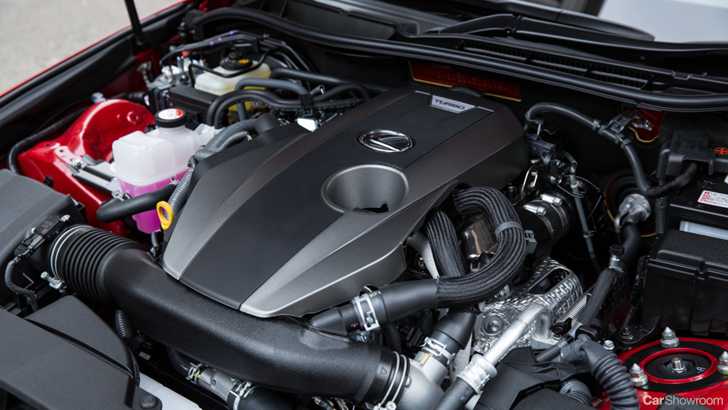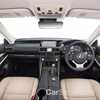The Japanese sporty exec saloon….at least in theory.
The best known of all Lexus cars besides the RX SUV has to be the IS, the compact executive saloon first developed and sold under the Toyota badge as the Altezza beginning in 1999. Now, nearing two decades into its evolution, we have this third-generation (XE30) Lexus IS, which first debuted in 2013 and facelifted for the 2017 model year.
If you’re the kind of person who just doesn’t resonate with cars like the BMW 3 Series, Mercedes-Benz C-Class, and Audi A4, the IS is definitely worth a look. Its place in the market, alongside those usual suspects, might not be as immediately obvious, but there is no longer a chasm between 'them' and the Lexus IS.
It has the sharp looks requisite in this space, is superbly engineered and constructed, offers a plush interior, some strong engines - heck, even the classic front-engine, rear-drive layout is present. But for the life of its existence, it has remained something of a outlier. Or, is it one of the best kept secrets in the automotive realm?
The IS on sale in Australia in three variants, the entry IS 200t, mid-range IS 300h, and the IS 350 topping off the range. All versions come with a generous amount of standard kit if compared tier-for-tier against many of its German rivals and stands up to scrutiny for value as well. No matter which drivetrain package is chosen, buyers can choose between the ‘Luxury’ or more aggressive/expensive ‘F Sport’, and ‘Sports Luxury’ trim levels.
Exterior
“The Lexus IS has a purposeful stance that communicates its readiness to take on whatever the day brings, whether chasing canyon bends or a night on the town.” - The Car Connection
For sheer dimensions, this 3rd-gen IS is technically the largest there has ever been, although not by much and is near impossible to discern based on observation alone. Lexus has pushed the axles further apart and have given the car some extra width. These alteration are in service of improved space for occupants, a topic which we’ll get into later.
First introduced in 2013 and receiving a minor facelift for 2017, that body is definitely not of the typical variety, and there’s no mistaking it for anything except a Lexus with its many diagonal creases and knife-like features - very anime, very…Japanese. Still, Toyota’s luxury sub-brand hasn’t gone overboard to differentiate itself. Its silhouette and proportions are indicative of a distinguished, even subtly aggressive car.
Built around a more advanced lightweight shell that improves upon its predecessor’s torsional rigidity, the most accurate word to describe the IS’ styling, along with the other Lexus cars that follow this ‘L-Finesse’ design philosophy, is ‘distinctive’. It’d be tough to argue with any accusation of that being untrue.
Some may lament the seemingly uniform look of some premium marques, especially when painted in a similar colour, and while the older IS wouldn’t have that much trouble assimilating among European contenders, this one stands apart and even plays into the nonconformist bent of their customers.
Engines and Drivetrain
“The 2.0-litre turbocharged engine in the IS200t delivers good performance in all situations, and it is especially nice in gentle driving around town.” - Whichcar
Though partial electric power has previously been introduced to other models in the Lexus line-up, this generation marks the first time the IS is being offered as a hybrid (rebranded as Lexus Hybrid Drive). Luckily, parent company Toyota’s extensive knowledge in this powertrain pays off, improving fuel economy while maintaining the power of a larger engine.
The range starts with a 2.0-litre turbocharged four-cylinder engine for the IS 200t, the only motor here to use forced induction. It develops a healthy 180kW and 350Nm, par for the course for a turbo petrol of comparable size but markedly more performance than any of the Germans at the entry level. Power is sent rearward via an 8-speed conventional (torque converter) automatic with paddle shifters.
The mid-level IS 300h uses a 2.5-litre Atkinson-cycle naturally aspirated four-cylinder engine working in tandem with an electric motor to produce a combined output of 164kW, though because it transmits power through a Continuously Variable Transmission (CVT), it shouldn’t be looked upon by those who prioritise fun over efficiency, with some criticisms being levelled against it for sapping the fun out of what could have been a powerful but economical ‘sweet spot’ variant. That said, the engine is a very refined performer and despite the transmission, can propel the IS at a decent rate.
Capping off the range of engines is the IS 350’s motor, which is a more old school naturally aspirated 3.5-litre V6 engine that delivers 233kW and 380Nm, mated to an 8-speed automatic with paddle shifters, same as the turbo four pot petrol.
During normal driving situations, it doesn’t offer that much more performance over the IS 200t’s turbo engine or even the IS 300h’s hybrid drive, but it is the most involving and vocal of the bunch and a fitting partner for the car’s striking exterior, especially paired with the F Sport's aggressive touches and adaptive suspension.
While both implementations of the 8-speed automatic are preferable to the CVT in most cases, it isn’t a class-leading transmission with manually selected shifts taking that hair longer to execute than competitors
Interior
“Inside the cabin, you’ll find the usual Lexus quality and finishing touches, which give the interior a sense of quiet, insulation and comfort.” - CarAdvice
Lexus has always been known for their near-obsessive levels of build, and the IS of now is no different, with a great spread of plush materials interspersed with satin finished metal and smooth leather, fastidiously put together.
But while the cabin is impeccably constructed, opinions tend to differ regarding its more subjective points. The layout itself isn’t an immediate aesthetic win. Other manufacturers have perfected the art of being effortlessly stylish or even managing to look instantly luxurious without needing to prove its tactility.
With the IS, Lexus hasn’t or perhaps doesn’t quite care about giving the driver and occupants a larger sense of occasion concerning the in-car experience. Everything is cleanly and logically laid out, easily understood and well within reach, but it’s all a little too efficient for its own good where some flair would have been appreciated over ultimate ergonomics.
There’s plenty space, the excellent seats are comfortable and supportive, and even the driving position instills a sense of sportiness. The buttons and switchgear, too, are clearly ofhigh quality and will easily last the car’s lifetime without ever hinting at becoming squidgy. Again, ultimate quality, logic and simplicity at the expense of flair.
Those who are familiar with the LFA supercar may notice some common cues, especially up front, but the effect of the stepped dashboard, sharper angles and sweeping lines don’t feel as cohesive here.
Some larger rear passengers might be wanting for legroom, though, as the longer wheelbase over its predecessor doesn't really amount to an appreciable increase in cabin space. It isn’t as pokey as the Jaguar XE but is still behind the class leading Audi A4 in this regard - about on par with BMW and Mercedes-Benz, though.
Boot space, at 480-litres, is similar to other cars in the premium executive space too, but the hybrid’s NiMH battery does eat into that resulting in a higher boot floor and 450-litres.
Behind The Wheel
“The IS lacks the involvement to keep keener drivers interested, and so it doesn’t have the sheer breadth of ability of the best cars it’s up against.” - Autocar UK
This third-generation IS shares a common platform with its predecessor, and thus shouldn’t differ all that much given its underpinnings hasn’t endured much change. The previous IS favoured comfort over dynamism, but this new version is clearly centred around that ‘sporty’ image.
In that transition, Lexus has firmed up the standard suspension setup, with the F Sport being even more so. Show it a corner and the IS responds with hardly any body roll, remains poised, agile, and inspires confidence through the nicely judged steering.
The brakes have also been made larger in all versions, but that’s because the IS does arguably need them, tipping the scale at over 1,600kg. Thankfully, that heft does seem to be masked well in normal driving.
Those looking for a more engaging drive should definitely opt for the IS 350 with its muscular V6. It won’t be as fuel efficient as the turbocharged petrol motor and won’t match it for early torque response, but overall it's the most fun in most situations.
Lexus might be shifting toward being perceived as a sporty luxury marque, but the IS is still behind some key competitors they doubtless were benchmarked it against. The adaptive suspension on the F Sport and Sports Luxury grades will allow finer control over how the car behaves, and is useful to offset the inherently firm ride when set to its most forgiving of presets.
Safety and Technology
“It’s unreasonably difficult to navigate using the mouse-like cursor – and while this is likely to become easier with practice, it’s just not as intuitive as the BMW or Audi equivalent.” - AutoExpress
With the IS acing every safety test thrown its way, including Euro NCAP and ANCAP’s to which it received 5 stars, the small Lexus sedan comes with all the safety accoutrements that one might expect and even wish to have - both active and passive - in a car of this sort.
A total of 10 airbags come as standard, as does the Pre-Collision system which uses radar and forward-facing camera to anticipate a collision and react quicker than the driver could to avoid a accident, working at city speeds all the way up to 180km/h. The same array of sensors also enable adaptive cruise control and lane departure warning, though blind spot monitoring is only for F-Sport and Sports Luxury versions.
It’s also got LED headlamps as standard that are also adaptive - automatically turning on and off while adjusting its beam for further illumination and lowering them for oncoming cars. Also automatic are the windshield wipers.
Inside, there’s dual-zone climate control, a 10.3 inch touchscreen central display with navigation, an optional Mark Levinson sound system, and a standard digital instrument panel inspired, again, by the LFA.
However, the input methods Lexus has employed for the infotainment system don’t work as well as others. The interface and system response makes it seem dated and the scrolling touchpad doesn’t work as accurately it should in practice, becoming downright frustrating to cycle through functions when not stationary and concentrating.
Verdict
With the third generation IS, Lexus has refined the formula enough to create a formidable compact executive saloon contender. The first iteration was lauded for being a sharp drive while the next was more focused on comfort and a sophisticated ride - this blends both.
But while it does a lot of things right, there’s not really a clear are where the IS excels insofar as it intersects with the interests of the buyers that it’s aiming to convert. In any trim, it is a very smooth and refined thing to drive, that’s for sure, surpassing most German rivals in this respect, especially the hybrid IS 300h, pairing very well with its superb build.
Although, this works to its detriment when considering how seemingly incongruent it is with the aggressive styling. If the IS’ real strength is as a supreme road-wafter, it certainly doesn’t look the part. Every engine option here does provide good pace but never really followed through with an engaging drive - you might be travelling quickly but never really being cognisant or necessarily appreciative of the sensation.
Objectively, the IS it’s a very good car that ticks all the right boxes for performance, quality, technology, and efficiency. It will also almost certainly get you that ‘against the grain’ appeal as you park alongside colleagues and their predictably German rivals in the office parking lot, which to many is alone worth the defection to the Lexus camp.
Autocar UK - 3.5/5 - “The resulting IS300h is competitive with big-selling diesel rivals on price, performance, handling and economy. It also sets an exceptional standard for refinement and quality, and its styling certainly cuts a distinctive dash on the road.”
Motor Trend - 4/5 - “The Lexus IS 350, especially in F Sport trim, features a great balance of ride and handling, and is priced lower than many German competitors. Owners will also enjoy the IS 350’s cabin, which is built with high-quality materials all around.”
CarAdvice - 8/10 - “Build quality and comfort; ride and handling is better than you'd expect; steering is shaper and precise; more power and torque than outgoing IS250, while using less fuel.”
The Car Connection - 8/10 - “The 2016 Lexus IS doesn't quite hit the high-water mark set by German rivals, but it's a pleasantly capable compact luxury car.”
AutoExpress - 4/5 - “The Lexus IS is a desirable, stylish and well-built alternative to more mainstream German executive saloons. Rather than copying the competition, Lexus has forged its own path with the IS. It’s brimming with kit, though, and the interior is crafted from sumptuous materials.”
CarsGuide - 3.5/5 - “Its in-your-face design brief will not appeal to everyone, but kudos for swinging for the fence. There are plenty of people who are more than happy to step away from the norm and into something with a bit of personality.”
Whichcar - 4/5 - “The Lexus IS is a sports sedan from Japan that brings you more luxury for the money than alternatives from Europe. It is beautifully put together, rides and drives very well, and offers a hybrid drivetrain among three engine options.”























